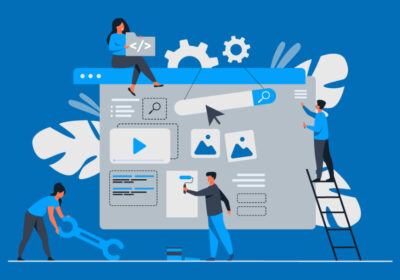
Building Engaging Web Applications: A Comprehensive Guide
Web applications have become an essential part of our digital lives, providing a wide range of services and functionalities. From e-commerce platforms to social media networks, web apps play a crucial role in connecting people and businesses. In this comprehensive guide, we’ll explore the key steps involved in engaging web applications development.
Understanding Web Applications
A web application is a software application that runs on a web server and is accessed through a web browser. Unlike desktop applications, web apps don’t require installation and can be accessed from any device with an internet connection.
Planning Your Web Application
Before diving into development, it’s essential to have a clear plan for your web application. Consider the following:
- Purpose: Define the purpose and goals of your web application.
- Target Audience: Identify your target audience and their needs.
- Features: Determine the key features your application will offer.
- Technology Stack: Choose the appropriate programming languages, frameworks, and tools.
Designing a User-Friendly Interface
A well-designed user interface (UI) is crucial for a successful web application. Focus on creating a clean, intuitive, and visually appealing interface. Use clear and concise labels, consistent navigation, and appropriate typography. Consider the user experience (UX) from the very beginning and test your application with real users to gather feedback.
Front-End Development
The front-end of your web application is what users see and interact with. It involves creating the visual elements and user interface. Popular front-end technologies include:
- HTML: The structure of your web pages.
- CSS: The styling and layout of your web pages.
- JavaScript: Adds interactivity and dynamic features to your web pages.
- Front-End Frameworks: Frameworks like React, Angular, and Vue.js can streamline front-end development.
Back-End Development
The back-end of your web application handles the server-side logic, database interactions, and business rules. Popular back-end technologies include:
- Programming Languages: Python, Ruby, PHP, and Node.js are common choices.
- Frameworks: Frameworks like Django, Ruby on Rails, Laravel, and Express.js can simplify back-end development.
- Databases: Databases like MySQL, PostgreSQL, MongoDB, and Firebase are used to store and manage data.
Full-Stack Development
Many developers choose to specialize in full-stack development, which involves working on both the front-end and back-end of web applications. This allows for a more holistic understanding of the development process.
Testing and Debugging
Thorough testing is essential to ensure your web application functions correctly and provides a seamless user experience. Test your application on different browsers, devices, and screen sizes to identify and fix any bugs or issues. Use testing tools and frameworks to automate testing and improve efficiency.
Deployment and Maintenance
Once your web application is ready, you need to deploy it to a web server. Choose a suitable hosting provider and configure your server to run your application. After deployment, continue to monitor your application’s performance, address any issues, and implement updates as needed.
Deployment and Maintenance: Ensuring Your Web Application’s Success
Once you’ve developed your web application, the next step is to deploy it to a web server so it can be accessed by users. Deployment involves configuring your application to run on a specific server environment and making it accessible to the public.
Deployment Strategies
- Manual Deployment: Manually copy your application files to the web server. This approach is suitable for small-scale projects but can be time-consuming and error-prone for larger applications.
- Continuous Integration/Continuous Deployment (CI/CD): Automate the deployment process using CI/CD pipelines. This ensures that your application is automatically built, tested, and deployed whenever changes are made to the codebase.
- Cloud Deployment: Use cloud platforms like AWS, Azure, or Google Cloud Platform to deploy and manage your web application. Cloud platforms offer scalability, reliability, and managed services.
Web Server Configuration
Configure your web server (e.g., Apache, Nginx) to serve your web application files. This involves setting up virtual hosts, configuring security settings, and optimizing performance.
Domain Name and DNS
Register a domain name for your web application and set up DNS (Domain Name System) records to point the domain to your web server.
Monitoring and Performance Optimization
- Performance Monitoring: Use tools to monitor your application’s performance, including response times, error rates, and resource usage.
- Optimization: Identify and address performance bottlenecks to improve user experience.
- Caching: Implement caching mechanisms to reduce server load and improve response times.
- Content Delivery Network (CDN): Consider using a CDN to distribute your website’s static content across multiple servers for faster delivery.
Security
- Regular Updates: Keep your web application and its dependencies updated to address security vulnerabilities.
- Security Audits: Conduct regular security audits to identify potential vulnerabilities and take corrective measures.
- Web Application Firewall (WAF): Consider using a WAF to protect your application from common web attacks.
Maintenance and Updates
- Regular Updates: Implement a maintenance schedule to regularly update your application with new features, bug fixes, and security patches.
- User Feedback: Gather user feedback and address any issues or requests.
- Scalability: Ensure your application can handle increased traffic and growth.
By following these best practices for deployment and maintenance, you can ensure that your web application remains accessible, reliable, and secure for your users.
Accessibility in Web Development: Building Inclusive Websites
Accessibility is essential for ensuring that your web application is usable by people with disabilities. By making your website accessible, you can broaden your audience and create a more inclusive online experience.
Understanding Web Accessibility
Web accessibility refers to designing and developing websites that are usable by people with disabilities, such as blindness, deafness, or motor impairments. It involves adhering to accessibility standards and guidelines to make your website accessible to everyone.
Accessibility Standards
- Web Content Accessibility Guidelines (WCAG): WCAG is the primary standard for web accessibility. It provides guidelines for making websites accessible to people with disabilities.
- Section 508: A U.S. federal law that requires federal agencies to make their websites accessible to people with disabilities.
Key Accessibility Features
- Alternative Text for Images: Provide descriptive alternative text for images to assist users who are visually impaired.
- Meaningful Link Text: Use descriptive link text that accurately conveys the destination of the link.
- Keyboard Navigation: Ensure your website is fully navigable using a keyboard, without requiring a mouse.
- Color Contrast: Maintain sufficient color contrast between text and background to improve readability for users with visual impairments.
- Audio and Video Captions: Provide captions for audio and video content to benefit users who are deaf or hard of hearing.
- Form Labels: Associate labels with form fields to assist users who are visually impaired or using screen readers.
- Focus Indicators: Clearly indicate the current focus for users who are visually impaired or using keyboard navigation.
- Responsive Design: Ensure your website is accessible on various devices and screen sizes.
Accessibility Testing
- Manual Testing: Manually test your website to identify accessibility issues.
- Automated Testing: Use automated testing tools to scan your website for accessibility violations.
- User Testing: Involve users with disabilities in your testing process to get feedback and identify potential barriers.
Accessibility Tools
- Screen Readers: Assist users with visual impairments by reading the content of the page aloud.
- Magnifiers: Enlarge text and images for users with low vision.
- Keyboard Shortcuts: Provide keyboard shortcuts for common actions to improve accessibility for users with motor impairments.
Accessibility and SEO
Making your website accessible can also improve its search engine optimization (SEO). Search engines prioritize accessible websites, which can lead to higher search engine rankings.
SEO for Web Applications: Optimizing Visibility and User Experience
Search Engine Optimization (SEO) is crucial for web applications to improve their visibility in search engine results and attract organic traffic. By implementing effective SEO strategies, you can increase your application’s discoverability and reach a wider audience.
Understanding Web App SEO
SEO for web applications differs slightly from traditional website SEO due to the dynamic nature of web apps. Here are some key considerations:
- Client-Side Rendering (CSR): If your web app uses CSR, search engines may have difficulty crawling and indexing your content. Consider using server-side rendering (SSR) or pre-rendering to improve SEO.
- JavaScript Frameworks: Ensure that your JavaScript framework (e.g., React, Angular, Vue.js) is SEO-friendly and doesn’t hinder search engine crawlers.
- Rich Snippets: Implement structured data markup to display rich snippets in search results, providing more information to users and increasing click-through rates.
- Mobile-First Indexing: Optimize your web app for mobile devices, as Google prioritizes mobile-first indexing.
- App Store Optimization (ASO): If your web app has a mobile app component, optimize its listing in the app store to improve visibility and downloads.
On-Page SEO for Web Apps
- Keyword Research: Identify relevant keywords that your target audience is searching for.
- Meta Tags: Use descriptive meta titles and meta descriptions for each page of your web app.
- Header Tags: Use appropriate header tags (H1, H2, etc.) to structure your content and improve readability.
- URL Structure: Create clean and descriptive URLs that include relevant keywords.
- Content Quality: Create high-quality, informative, and engaging content that meets the needs of your target audience.
Technical SEO for Web Apps
- Page Speed: Optimize your web app’s loading speed to improve user experience and search engine rankings.
- Mobile-Friendliness: Ensure your web app is fully responsive and accessible on mobile devices.
- Sitemap: Create an XML sitemap to help search engines crawl and index your web app’s content.
- txt: Use a robots.txt file to instruct search engines which pages to crawl and which to avoid.
Off-Page SEO for Web Apps
- Link Building: Build high-quality backlinks to your web app from other reputable websites.
- Social Media: Promote your web app on social media platforms to increase visibility and engagement.
- Local SEO: Optimize your web app for local search if it targets a specific geographic area.
Measuring and Improving Web App SEO
- SEO Analytics: Use tools like Google Search Console and Google Analytics to track your web app’s performance in search engine results.
- Keyword Ranking: Monitor your website’s keyword rankings and make adjustments as needed.
- User Engagement: Track user engagement metrics, such as bounce rate and time on page, to assess your SEO efforts.
- A/B Testing: Experiment with different SEO strategies to identify what works best for your web app.
By implementing effective SEO strategies, you can improve your web application’s visibility in search engine results, attract more organic traffic, and ultimately achieve your business goals.

















